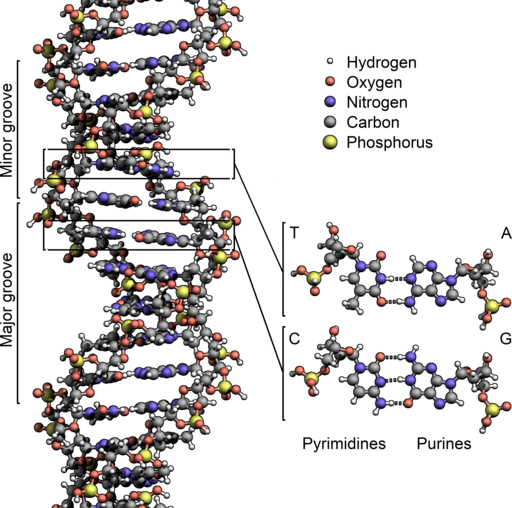So we have come to the last leg in our journey. We started out with a question - Can we believe in God and still be a scientist? Along the way we took several different steps:
Looking Upward - Psalm 19:1-2 (NIV) The heavens declare the glory of God; the skies proclaim the work of his hands. Day after day they pour forth speech; night after night they reveal knowledge. - Finding God in the universe above.
Here we studied the Big Bang theory, examined the probability of a rare Earth, and then focused on the possibility of life on any planet.
Turning Outward - Proverbs 25:2 (NIV) It is the glory of God to conceal a matter; to search out a matter is the glory of kings. - Finding God in the world around us.
This zoomed us in on the Earth, first taking a closer look at the sky (atmosphere) above us. Then we moved closer still and looked at some of the special features of our planet itself.
Searching Inward - Psalm 139:13-14 (NIV) For you created my inmost being; you knit me together in my mother's womb. I praise you because I am fearfully and wonderfully made; your works are wonderful, I know that full well. - Finding God in the formation of the human body, and thus in life itself.
In this third part of the series, we defined life as best we could, examined the simplest life forms, compared Evolution and the Cambrian Explosion, dinosaurs and DNA, how complex even simple life is and how we are made in the image of God.
Now we move on to our last segment:
Moving Forward - Ephesians 2:10 (NIV) For we are God's handiwork, created in Christ Jesus to do good works, which God prepared in advance for us to do. - How do you take this to the next level - confirmation of your faith, or lack thereof. There is more to life than just "existing."
Those who hold that Science is the final arbiter of facts want us to believe that this is all there is, that the glorious advancement of Science will make our existence “heaven on earth” and that there is nothing beyond this life. But our belief in God give us a “hope” in our future and tells us there is more in and beyond this life if we just believe.
In this last segment, we will identify specific passages from the Bible that speak of scientific fact or theory before it was considered science! This will give us a basis for sharing how science and faith can co-exist, they do not have to be mutually exclusive. But in the end, we each must decide - Do we believe in the God of the Bible, and His science, or do we believe in secular science, which specifically eliminates God from the equation because His existence cannot be proven.
Remember, Science cannot claim that God created anything because God has to be outside of our dimensions of time and space to be able to create our universe, and science only functions within the physical universe we know. Even though God has invaded His creation, He is not physically manifested in it, as we know it scientifically. So God cannot be proven to exist in the context of science. Thus He also cannot be called on as a "proof of life" or a Creator. Science must have a reason, a physically testable reason, for the how and why something exists. God cannot be tested but He can be observed in His creation - as Paul writes in Romans 1:20 (NIV): "For since the creation of the world God’s invisible qualities—His eternal power and divine nature—have been clearly seen, being understood from what has been made, so that people are without excuse."
God’s invisible qualities
His eternal power and divine nature
have been clearly seen,
being understood from what has been made,
so that people are without excuse. - Romans 1:20 (NIV)
But remember to “speak the truth in love (Ephesians 4:15 (NIV))” with patience, and listen to find areas of common ground when sharing with others. Do not just dump scripture on others but find out what they are thinking and help them understand the Biblical point of view. You may be surprised that you have more in common than you realize. God wants us to learn to love. We can do this by seeing how much He loves us through His Creation.
So now here are some specific examples from the Bible that can be used when discussing science and religion with others.
Some of the Bible’s scientific passages (Scientific concepts supported by Scripture):
Genesis 1:1 – In the beginning God created the heavens and the earth.
Genesis 1:2 – The earth was formless and void, and darkness was over the surface of the deep, and the Spirit of God was moving over the surface of the waters.
Genesis 1:16 – God made the two great lights, the greater light to govern the day (sun), and the lesser light to govern the night (moon); He made the stars also.
Job 25:2 – Dominion and awe belong to Him who establishes peace in His heights.
Job 26:7, 10 - He stretches out the north over empty space and hangs the earth on nothing. (10) He has inscribed a circle on the surface of the waters at the boundary of light and darkness.
Isaiah 40:22 – …Who stretches out the heavens like a scroll and spreads them out like a tent to dwell in.
Ecclesiastes 1:9 - That which has been is that which will be, and that which has been done is that which will be done. So there is nothing new under the sun.
Ecclesiastes 3:14-15 – I know that everything God does will remain forever; there is nothing to add to it and there is nothing to take from it, for God has so worked that men should fear Him. That which is has been already and that which will be has already been, for God seeks what has passed by.
Ecclesiastes 1:7 - All the rivers flow into the sea, yet the sea is not full. To the place where the rivers flow, there they flow again.
Isaiah 55:10 – For as the rain and the snow come down from heaven, and do not return there without watering the earth and making it bear and sprout, and furnishing seed to the sower and bread to the eater;
Job 26:7 – He stretches out the north over empty space and hangs the earth on nothing.
Job 38:31-33 – Can you bind the chains of the Pleiades, or loose the cords of Orion? Can you lead forth a constellation in its season, and guide the Bear with her satellites? Do you know the ordinances of the heavens, or fix their rule over the earth?
Leviticus 13:45-46 – As for the leper who has the infection, his clothes shall be torn, and the hair of his head shall be uncovered, and he shall cover his mustache and cry, “Unclean! Unclean!” He shall remain unclean all the days during which he has the infection; he is unclean. He shall live alone; his dwelling shall be outside the camp.
Numbers 19 (the whole chapter)
Deuteronomy 23:12-13 – You shall also have a place outside the camp and go out there, and you shall have a spade among your tools, and it shall be when you sit down outside, you shall dig with it and shall turn to cover up your excrement.
Hebrews 1:10-12 - He also says, “In the beginning, Lord, you laid the foundations of the earth, and the heavens are the work of your hands. They will perish, but you remain; they will all wear out like a garment. You will roll them up like a robe; like a garment they will be changed. But you remain the same, and your years will never end.”
Next we examine what Science predicts about the origins of life compared to the Biblical view.
Origin of Life - the Scientific view compared to the Biblical view (tables from reasons.org)
Table I - Some Predictions Made by the Naturalistic (Evolutionary) Origin-of-life Scenario
- Placid chemical and physical conditions existed on the early earth for long periods of time
- Chemical pathways that produce biomolecules would have been capable of operating under the conditions of the early earth
- Life originated only once
- Life emerged gradually over a long period of time
- Life in its minimal form is simple
Table II - Some Predictions Made by the Biblical Origin-of-life Scenario
- Life appeared early in Earth’s history
- Life appeared under harsh conditions
- Life miraculously persisted under harsh conditions
- Life arose quickly
- Life in its minimal form is complex
As we learn more about early life on our planet and how life existed in the past and lives on in the present, the scientific assumptions are giving way to the Biblical ones. It seems the more we learn the more it points to God as a Creator instead of random chance.
Now not only is the Bible filled with the fundamentals of science, but it is as much as 3,000 years ahead of its time. Biblical statements, when written, in most cases directly contradicted the science of the day. As modern scientific knowledge advances, the divine accuracy of the scriptures is substantiated. Here are some examples:
| Biblical Statement (NASB) | Science Then | Science Now |
| Earth is a sphere (Isaiah 40:22) | Earth is a flat disk | Earth is a sphere |
| Number of stars exceeds a billion (Jeremiah 33:22) | Number of stars totals 1,100 | Number of stars exceeds a billion |
| Every star is different (1 Corinthians 15:41) | All stars are the same | Every star is different |
| Light is in motion (Job 38:19-20) | Light is fixed in place | Light is in motion |
| Air has weight (Job 28:25) | Air is weightless | Air has weight |
| Winds blow in cyclones (Ecclesiastes 1:6) | Winds blow straight | Winds blow in cyclones |
| Blood is a source of life and healing (Leviticus 17:11) | Sick people must bleed | Blood is a source of life and healing |
- Isaiah 40:22 – It is He who sits above the circle of the earth… (“chuwg“ – circle or sphere)
- Jeremiah 33:22 - As the host of heaven cannot be counted and... (A very large number)
- 1 Corinthians 15:41 - …and another glory of the stars; for star differs from star in glory - (“doxa“ – brightness)
- Job 38:19-20 - “Where is the way to the dwelling of light? …that you may discern the paths to its home? – (“shakan” – reside)
- Job 28:25 - When He imparted weight to the wind and meted out the waters by measure – (“mishqal” – weight, heaviness)
- Ecclesiastes 1:6 - The wind continues swirling along; and on its circular courses the wind returns. – (“cabab” – change direction)
- Leviticus 17:11 - For the life of the flesh is in the blood, and… - (“nephesh” – life, living being)
The probability that the biblical writers, writing between 2,000 – 4,000 years ago, would have guessed all these details is less than one in many trillions.
In the crucible of scientific investigation, the Bible has proven invariably to be correct. No other book, ancient or modern, can make this claim; but then, no other book has been written (through men) by God. I think as we learn more through scientific study and examination, if we are reasonable and open, we will see the hand of God at work.
(Most of the biblical references come from Reasons to Believe)




